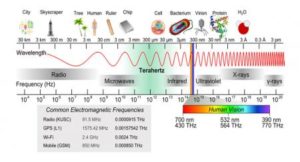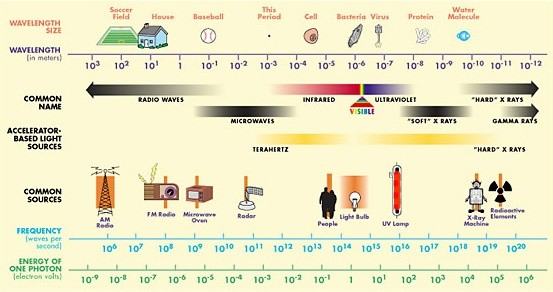5G systems promise to provide a vast increase in capacity to support 5G enhanced mobile broadband services. Higher frequencies in the millimeter-wave region, offer larger channel bandwidths and higher data rates. 5G NR has already allocated 26/28 GHz, while there are ongoing discussions for 60GΗz as well. In the wireless backhaul area, 80GHz Eband and 60GHz Vband are already in use. There are also plans to break the 100GHz barrier by providing commercially available wireless backhaul systems in D-Band (130-170GHz) by 2021.
But what about future technologies that can create added value to advanced 5G services? Advanced wireless technologies that can reach ultra-high capacities such as Tbit/s in the following years and may shape the way for 5G and the next generation systems? Terahertz wireless technology is one of them.
Terahertz spectrum characteristics
Terahertz frequencies typically cover the range of 100 GHz or 0.1THz up to 30 THz. In the electromagnetic spectrum, terahertz frequencies lie after the microwave and millimeter-waves and just before the infrareds.
Signals in that region have very short wavelengths, lower than a millimeter and that is why they are also known as Submillimeter-waves.

Terahertz signals, due to their characteristics, can penetrate materials and provide high resolution, without causing harm to human tissue. Microwaves are also penetrating but have low resolution, while X-ray radiation has higher resolution but may damage living tissues and DNA. That is why Terahertz technology can be used for a variety of applications, from communications to medical imaging.
Terahertz Applications
Space: THz can be used for various space applications since it can aid Earth Science by monitoring the atmosphere and how it changes, observing cloud dynamics, measuring ozone depletion, etc.
In Astrophysics, we will be able to study galaxies far away and explore star formation and star decay. THz can also be used for Planetary Science by observing distant planetary atmospheres. Furthermore, it can aid the search for volcanic and life signatures, provide active altitude control for landing, etc. Finally, it may also have application in Bioastrophysics, by the detection of bio-molecules, detection of habitability, and more.
Defense
The defense sector is another area of THz application. Using THz Imaging can help on real-time detection of threats and the determination of dangerous objects via the provision of THz pictures. It can also aid on Phenomenology, with detection of minute amounts of detrimental agents, such as poison gas, plastic explosives, etc. Secure communications is another application since THz can support un-penetrable and secure links.
Commercial/Social
THz imaging can be used for contraband detection and on the medical sector by the detection of bio-molecules, cancer, tooth decay, etc. Structural uniformity and integrity is another area where THz can be applied to look for any deformities and cracks in material, ink uniformity.
Terahertz technology benefits
As mentioned above, moving to higher bands will result in higher throughputs due to the broader available spectrum. The trend is currently to migrate from traditional cellular and microwave bands to the millimeter-wave region, where more spectrum is available. The FCC had appointed 10GHz for E-band and is about to allocate up to 40GHz spectrum for D-Band. In the Terahertz region, vast amounts of spectrum can be used. It is, therefore, expected that Terahertz technology, when commercially available, will give the extra edge to 5G wireless applications and next-generation systems by providing Tbps communications.
Having a sizeable available spectrum means not only higher throughputs but also high speeds using lower modulation schemes. This, in turn, will result in lower transmission delay times.
At THz band frequencies, there is very high atmospheric attenuation that affects the signal transmission. Antenna arrays will, therefore, be used to compensate on system gain. Due to the pencil-beam nature of the signal and the use of high-directional antenna arrays, THz signals will be difficult to intercept and will provide additional security on the radio interface.
Another benefit due to its small pencil-beam signal nature is that terahertz equipment is expected to have a small form-factor, just as it is the case with the upcoming D-Band products compared to traditional frequency equipment.
Terahertz challenges
A typical THz application would be to detect concealed weapons or a bomb hidden behind a jacket. There have been trials where the concept was to perform standoff through-garment weapons detection using ultra-high-resolution terahertz radar at 660-690 GHz. Pilot trials will follow in crowded public in areas such as airports or central train stations.
In the above threatening example of a potential terrorist attack, the challenge is how to receive and analyze the THz images faster. The mechanical movement of the mirrors limits this function. The radar needs to image moving targets or crowd-scanning. For many beams on a target, the equipment requires a focal-plane submillimeter-wave transceiver array. Transceiver arrays above 100 GHz are challenging, and easily scalable technology for multiple beams is required.
THz electronics for the time-being are packaged in bulky metal waveguide circuits. Furthermore, the material is still expensive, and the target cost is still a long way until we reach a commercially available product.
The main challenge for THz technology is, therefore, to reduce cost, mass, and volume. All the above should take place without sacrificing performance and be able to allow scaling in pixel count and frequency. Multi-pixel THz imagers present technical challenges, and silicon micromachining provides a way forward.
Terahertz Technology next steps
There are apparent technical advancements need to be made in specific areas. Extensive research is needed in semiconductor technology for the RF, analog baseband, and digital logic. New modulation, synchronization methods, and large antenna array systems are necessary to improve spectral efficiency to achieve Tbps data-rates.
There is also extra effort needed regarding the regulatory situation at frequencies above 300GHz. The ITU and the industry, in general, have not reached a final consensus yet. Terahertz frequency area is still unclear and certainly not harmonized. There is still a lot of work required by researchers, the industry, and standardization bodies to reach a final agreement.
With all the above challenges ahead, it is more likely to use a more scalable approach for the introduction of THz technology. The technological advancements towards THz can be reached in different phases. First off, by launching the first commercial solutions above 100GHz in the D-Band region. Then, proceed with higher frequencies by developing and standardizing products to offer speeds up to 300 Gb/s. Finally, continue with the appropriate technological breakthroughs and advanced wireless mechanisms to achieve Tbps wireless speeds.
This scalable approach can provide a solid evolution path to 5G to reach 5G maturity and take the technology to the next level. THz technology is still a long way from becoming a reality, but it is destined to revolutionize the 5G ecosystem and pave the way for the next-generation systems of wireless communications.













